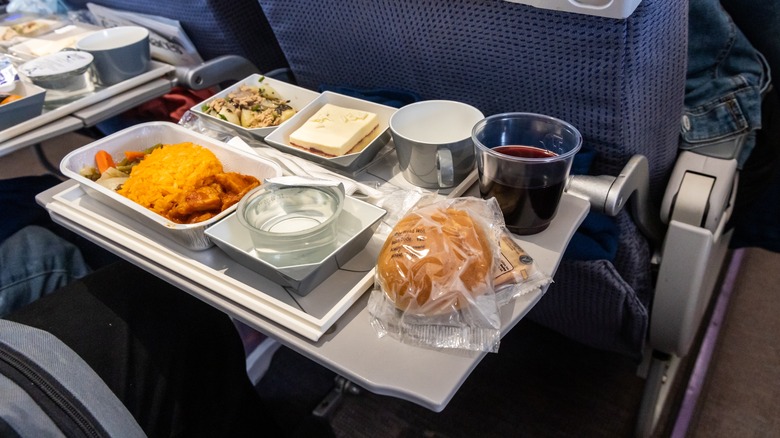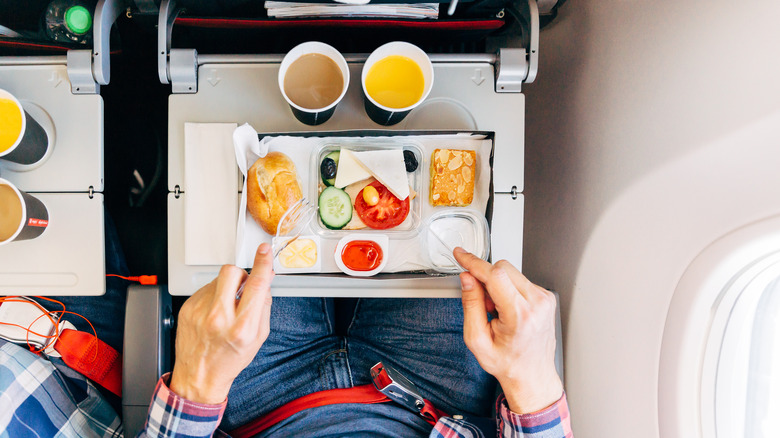Here's Why Gordon Ramsay Won't Eat Airplane Food
Airplane food isn't exactly known for being gourmet. Sure, some airlines have stepped up their game, dishing out surprisingly tasty meals to keep passengers happy. It's no wonder some folks have sneaky hacks to get their meals quicker — they're itching to dig into those little trays. But there are also plenty of travelers who avoid these meals like the plague. Whether it's the fear of food poisoning, avoiding allergy triggers, or just thinking the meals are plain gross, the reasons are endless. Even Gordon Ramsay wouldn't dare touch it — and he used to be the one making it! Then again, his inside knowledge of airplane food making is precisely what drives his aversion.
It's kind of ironic that someone who has an establishment called Gordon Ramsay Plane Food wouldn't be caught dead scarfing down airplane grub. Despite his history crafting menus for airlines like Singapore Airlines —now renowned for some of the best in-flight dining experiences — he still has zero appetite for it. "There's no f***ing way I eat on planes," he once told Refinery29. "I worked for airlines for 10 years, so I know where this food's been and where it goes, and how long it took before it got on board." But maybe that's just classic Gordon for you. These days, airlines appear to be making a real effort to upgrade their offerings — including the people sitting in coach (more on this later). There's hope for having a decent meal at 30,000 feet, after all.
Gordon Ramsay isn't impressed with the quality of plane food
Airlines are trying to improve their food, but convincing Ramsay to dig in might be a challenge. The "Hell's Kitchen" star hasn't detailed why he finds the process of making plane food so appalling, but he's definitely not a fan of the end result. "Airplane food isn't in a great state; so many of the airlines serve heavy, stodgy meals," he told Bon Appetit, adding that the poor quality is exactly why he decided to launch Gordon Ramsay Plane Food restaurant. "Last year we opened a restaurant at Heathrow's Terminal 5, where we offer these amazing picnics to take onboard. They're light, easy to carry, and most importantly, absolutely delicious."
Ramsay's critique of plane food quality doesn't mean he can't make it tasty, of course. He used to lend his culinary chops to Singapore Airlines, helping put together their in-flight menus as part of their prestigious International Culinary Panel (ICP). Interestingly, the dishes he created are served on bone china plates, with utensils designed by Givenchy.
It's not just all about fancy presentation, though. According to Off the Spork, Ramsay's beef dish for Singapore Airlines was the highlight of their trip from Melbourne to Cape Town. "The beef dish was exclusively created by Gordon Ramsay and finally! A great plane meal from Singapore Airlines!" they wrote. "The beef was tender and in a tasy [sic] sauce. The mashed potato was nice and creamy and not too bland. Hooray!"
How is airplane food made, anyway?
The plane food preparation process might not meet Gordon Ramsay's high standards, but it's not as bad as he suggests. Airlines are putting more thought into what they serve than you might expect. "The thing that people don't necessarily realize is the amount of work that goes into every aspect of it from the menu planning and how we select ingredients or how we choose partners all the way through sourcing and delivery and all the execution in the kitchen," Mike Henny, Delta's managing director of onboard service operations, shared with USA Today.
Cooking them is a serious operation, too. They're prepared in bulk at facilities near airports with strict sanitation standards — think "The Bear," but with less drama, more gloves, and lab coats. The food is then chilled and delivered to the plane about an hour before boarding. And yes, they're safe, as caterers are inspected and required to comply with FDA standards.
If you're still not thrilled with your in-flight meal, there are ways to improve it. Try wearing noise-canceling headphones — the secret to boosting the flavor of plane food. Or, bring a pocket-sized bottle of your favorite spice or sauce. "One of the things that I always carry with me is a little pocket salt," James Beard award-winning chef Nina Compton told CNN. "Sometimes I carry a little bit of Tobasco." Or simply bring the food you like — there are ways to make it pass through the TSA anyway.


